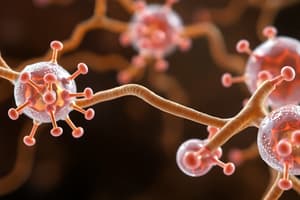Podcast
Questions and Answers
What is a key structural feature of G-protein coupled receptors (GPCRs)?
What is a key structural feature of G-protein coupled receptors (GPCRs)?
- They have a single membrane spanning region.
- They do not bind to ligands.
- They are exclusively located in the cytoplasm.
- They consist of 7 transmembrane helical segments. (correct)
What is the primary role of G-proteins in signaling pathways?
What is the primary role of G-proteins in signaling pathways?
- To act solely as enzymes in the cytoplasm.
- To directly bind to the ligand.
- To form stable complexes that do not change conformation.
- To cycle between active (GTP-bound) and inactive (GDP-bound) forms. (correct)
Which type of G-proteins is most commonly associated with signal transduction?
Which type of G-proteins is most commonly associated with signal transduction?
- Trimeric G-proteins with α, β, and γ subunits. (correct)
- G-proteins that are only involved in cytoskeletal functions.
- G-proteins that have no lipid attachment.
- Monomeric G-proteins.
What unique feature do Gβγ subunits of G-proteins exhibit?
What unique feature do Gβγ subunits of G-proteins exhibit?
Which of the following best describes the action of effector enzymes or ion channels regulated by G-proteins?
Which of the following best describes the action of effector enzymes or ion channels regulated by G-proteins?
What is the primary role of receptor proteins in cells?
What is the primary role of receptor proteins in cells?
Which feature is NOT characteristic of receptor proteins?
Which feature is NOT characteristic of receptor proteins?
What is the first step in the signal transduction process?
What is the first step in the signal transduction process?
Which of the following is NOT a type of action mediated by receptor proteins?
Which of the following is NOT a type of action mediated by receptor proteins?
What type of change do receptor proteins usually induce upon ligand binding?
What type of change do receptor proteins usually induce upon ligand binding?
The term 'signal transduction' refers to what process?
The term 'signal transduction' refers to what process?
What type of signaling involves the interdependent metabolic activities in different tissues?
What type of signaling involves the interdependent metabolic activities in different tissues?
Which extracellular chemical signaling type is characterized by its interaction with nearby cells?
Which extracellular chemical signaling type is characterized by its interaction with nearby cells?
What feature of signal transduction allows for the amplification of a signal within the pathway?
What feature of signal transduction allows for the amplification of a signal within the pathway?
Which type of signaling molecules can directly cross the cell membrane?
Which type of signaling molecules can directly cross the cell membrane?
Which property describes the ability of signal transduction pathways to integrate multiple signals into one response?
Which property describes the ability of signal transduction pathways to integrate multiple signals into one response?
What is the role of receptor tyrosine kinases in cell signaling?
What is the role of receptor tyrosine kinases in cell signaling?
What is a characteristic feature of GPCRs?
What is a characteristic feature of GPCRs?
Which of the following is true regarding ligand-gated ion channels?
Which of the following is true regarding ligand-gated ion channels?
What does desensitization in signal transduction refer to?
What does desensitization in signal transduction refer to?
In signal transduction, what does divergence imply?
In signal transduction, what does divergence imply?
Which component of a cell-surface receptor directly interacts with signaling molecules?
Which component of a cell-surface receptor directly interacts with signaling molecules?
Which of the following is NOT a feature of signal transduction pathways?
Which of the following is NOT a feature of signal transduction pathways?
Flashcards
Receptor Proteins
Receptor Proteins
Proteins in cells that receive and convert signals into cellular responses.
Signal Transduction
Signal Transduction
The process where a signal is converted into a chemical change in a cell.
Ligand
Ligand
A molecule that binds to a receptor, initiating a response.
Signal
Signal
Signup and view all the flashcards
Confomational Change
Confomational Change
Signup and view all the flashcards
Effector Specificity
Effector Specificity
Signup and view all the flashcards
Cellular Response
Cellular Response
Signup and view all the flashcards
Target Cell
Target Cell
Signup and view all the flashcards
GPCR Structure
GPCR Structure
Signup and view all the flashcards
G-protein Cycles
G-protein Cycles
Signup and view all the flashcards
Trimeric G-proteins
Trimeric G-proteins
Signup and view all the flashcards
G-protein Subunit Roles
G-protein Subunit Roles
Signup and view all the flashcards
Effector Activation
Effector Activation
Signup and view all the flashcards
Specificity in Signal Transduction
Specificity in Signal Transduction
Signup and view all the flashcards
Sensitivity in Signal Transduction
Sensitivity in Signal Transduction
Signup and view all the flashcards
Amplification in Signal Transduction
Amplification in Signal Transduction
Signup and view all the flashcards
Modularity in Signal Transduction
Modularity in Signal Transduction
Signup and view all the flashcards
Desensitization/Adaptation
Desensitization/Adaptation
Signup and view all the flashcards
Integration in Signal Transduction
Integration in Signal Transduction
Signup and view all the flashcards
Divergence in Signal Transduction
Divergence in Signal Transduction
Signup and view all the flashcards
Localized Response
Localized Response
Signup and view all the flashcards
Cell-surface receptors
Cell-surface receptors
Signup and view all the flashcards
Study Notes
Receptor Signaling and GPCRs
- The course is HuBi 2001 – Introduction to Biochemistry, taught by Renan Danielski.
- Learning objectives include understanding receptor proteins, signal transduction pathways, general signal transducers, extracellular chemical signaling, and G-proteins and GPCRs.
Receptor Proteins
- Animal cells exchange information regarding ion and glucose concentration in extracellular fluids.
- They also use this information for various metabolic processes in different tissues and proper cell development and positioning during various stages.
- Information in cells comes in the form of signals.
- Signals are converted into cellular response via receptors, a chemical process.
- Signal transduction converts information into chemical change in cells.
Receptor Proteins (continued)
- Receptors are not always in the cell membrane; they can be in other structures or even in the cytosol.
- Receptors have specific ligand binding.
- Binding usually leads to a conformational change.
- Receptors often have effector specificity.
- Receptors can mediate various actions including cell-cell signaling, adhesion, endocytosis and so on.
- Signal transduction often amplifies signals, which occurs quickly.
Signal Transduction Basics
- A signal (ligand) interacts with the receptor.
- The activated receptor interacts with cellular machinery.
- A second signal/protein activity change is produced.
- Metabolic activity changes in the target cell.
- Transduction event ends.
8 Features of Signal Transduction Pathways
- Specificity: Signaling ligand binds to the correct receptor; others do not fit.
- Sensitivity: Receptors have high affinity for specific ligands (low Kd).
- Amplification: Enzyme activation leads to a geometric increase in the number of affected molecules.
- Modularity: Diverse signaling complexes are formed via interchangeable proteins with reversible points of interaction.
- Desensitization/Adaptation: Receptor removal/inactivation occurs due to overwhelming signals.
- Integration: Multiple signals lead to unified outcomes (e.g., concentration of a second messenger or membrane potential).
- Divergence: One signaling event may lead to multiple downstream pathways.
- Localized Response: Signal processing and response is localized to avoid diffusion to distal parts of the cell.
General Types of Signal Transducers
- G protein-coupled receptor (GPCR): External ligand binds to the receptor, triggering a GTP-bound protein that regulates an enzyme to generate secondary messengers.
- Receptor enzyme (tyrosine kinase): Ligand binding activates tyrosine kinase activity via autophosphorylation.
- Gated ion channel: Channel opens or closes in response to signal ligand or membrane potential changes.
- Nuclear receptor: Hormone binding allows the receptor to regulate the expression of specific genes.
Extracellular Chemical Signaling
- Most extracellular ligands interact with membrane receptors as they are unable to directly pass through the membrane.
- Ligands vary in size, charge, hydrophobicity, etc. (e.g., small molecules, gases like nitric oxide, soluble proteins like hormones).
Extracellular Chemical Signaling (continued)
- Small and hydrophobic ligands cross the cell membrane and bind to intracellular receptors in the nucleus or cytoplasm.
- Polar and charged ligands bind to the extracellular domains of cell-surface receptors (e.g., peptide ligands like growth factors, insulin, neurotransmitters.)
Cell-Surface Receptors
- Composed of three domains: extracellular ligand-binding domain, hydrophobic transmembrane domain, and intracellular domain.
- Examples: ligand-gated ion channels, G protein-coupled receptors, receptor tyrosine kinases.
Ligand-gated Ion Channels
- Ligand binding opens ion channels allowing ions to bypass the membrane's hydrophobic core.
- Protein structural changes dictate whether the channel stays open or closed.
Receptor Tyrosine Kinases
- Enzyme-linked receptors located on the cell surface, and their intracellular domains are associated with an enzyme.
- Receptor tyrosine kinases transfer phosphate groups to tyrosine amino acids.
GPCRs
- Large family of receptors reacting to various extracellular signals, regulating cell activities.
- Activate trimeric G proteins (members of guanine nucleotide-binding proteins) functioning as intracellular signaling pathway switches.
- Activate/inactivate ion channels or effector enzymes generating second messenger molecules.
Signal Transduction through GPCRs
- Plasma membrane receptor with 7 transmembrane helical segments.
- G protein that cycles between active (GTP-bound) and inactive (GDP-bound) states.
- Effector enzyme (or ion channels) in the plasma membrane that is regulated by the activated G protein.
G-proteins
- G-protein-coupled receptor (GPCR) structure has 7 membrane-spanning regions, a C-terminal loop and tail for binding, and three different ligand-binding families.
- G proteins bind GTP and hydrolyze it; they are anchored in the membrane.
- Monomeric G-proteins are usually involved in gene expression and have an ON-OFF conformational change.
- Trimeric G proteins (α, β, γ subunits) are critical to receptor signaling in numerous pathways and can dissociate from each other during signaling.
G-protein Activation/Signaling Mechanism (from initial hormone binding)
- Hormone binding induces a conformational change in the receptor.
- Activated receptor binds to the G protein’s α subunit.
- Activated receptor GEF (guanine nucleotide exchange factor) activity stimulates the α subunit to release GDP and bind GTP.
- The α subunit dissociates from the βγ subunits and activates downstream effectors/enzymes.
- Hydrolysis of GTP to GDP causes the α subunit to reassociate with the βγ subunits.
- Gβγ may act as a signaling molecule instead of the α subunit.
Studying That Suits You
Use AI to generate personalized quizzes and flashcards to suit your learning preferences.




